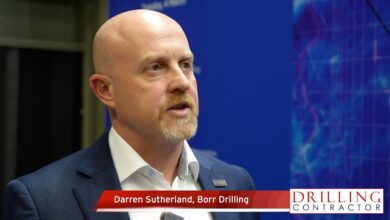70th Anniversary Retrospective
IADC celebrates its 70th anniversary in 2010. In recognition of this milestone, and in anticipation of the decades ahead, DC is publishing retrospectives from issues of decades past. We invite you to explore the the historical contrasts and similarities that may emerge and chart the industry’s evolution through these episodic vignettes. The past is written, and has brought us to 2010. But who knows what the future may hold?
7 YEARS
IADC Houston Chapter contributes to industry, charity
May 2003
IADC Houston Chapter is donating $5,000 to fund the revamping of the Life on a Rig exhibit on the Ocean Star Offshore Rig and Museum in Galveston, Texas. The exhibit will provide the visitors museum with a realistic experience of what it’s like to live onshore. IADC Houston Chapter is asking for donations of photos and equipment for the exhibit. “We are donating $5,000,” said Darryl Smith, IADC Houston Chapter Chairman, and General Manager of Operations for Atwood Oceanics. “We will be donating each year for the next two years.”
The Houston Chapter also donates to a local organization that supports a school for handicapped students, and is also a magnet school for gifted students. This year, the IADC Houston Chapter donated $40,000 to the organization.
19 YEARS
Horizontal well sets German depth record
Dec 1991
WHEN MOBIL Erdgas-Erdol GmbH (MEEG) Drilling decided to drill its first horizontal well, the Hamburg, Germany-based IADC member concluded it might as well set a new record.
So it did.
The Siedenburg Z-17 well, completed during April 1991 and the subject of a recept SPE/IADC technical paper, is the deepest horizontal well ever drilled in Germany. And its TVD of 11,202 ft (3,414 m) makes it one of the deepest in the world.
“After the reservoir engineering aspects of this project indicated a potential five- to eight-fold production increase with a 400-m-long horizontal-completion interval, the drilling and completion aspects were analyzed for technical feasibility,” wrote L. Niggemann of MEEG and R. Ehlers of Eastman Christensen. Their paper, “Horizontal Drilling in Depleted Sour Gas Reservoir,” was presented at the 1991 SPE/IADC Drilling Converence in Amsterdam.
And in addition to the technical drilling challenges, the team had two major safety concerns – sour gas (6.7% H2S) and under-balanced conditions. Due to previous production out of the zone of interest, the reservoir pressure was only 1,668 psi.
The well was drilled in the depleted Siedenburg field, which has been producing since its discovery in 1964. The well, located 50 miles northwest of Hannover, was drilled at an 85° inclination with a 1,088-ft horizontal section and an overall length of 1,362 ft.
MEEG wanted to maximize gas recovery while minimizing water influx and creating better access to the reservoir by boosting permeability thickness. At the same time, sour-gas production was to be increased to feed a nearby gas purification plant.
The operator contracted ITAG Rig No. 26, a Wirth GH-1500 with 350-ton hookload “(This) fully hydraulic drilling rig proved to be very effective for this application,” the authors wrote. “Drawworks and rotary table could be operated very precisely, which is especially helpful in the harsh downhole conditions experienced when drilling a medium-radius curve in a hard rock.”
35 YEARS
President Ford makes first visit to offshore rig
May 1975
 PRESIDENT GERALD M. FORD IS THE FIRST U.S. chief executive ever to pay a visit to an offshore drilling rig.
PRESIDENT GERALD M. FORD IS THE FIRST U.S. chief executive ever to pay a visit to an offshore drilling rig.
On April 23, President Ford traveled by military helicopter 96 miles from New Orleans to a drilling site in Grad Isle Block 88. There, in 341 ft. of water, 35 miles off the Lousiana Gulft coast, he toured the sophisticated “New Era” which belongs to Diamond M Drilling Co. and is under contract to Gulf Oil Corp.
The football field-size “New Era”, which cost $28 million, is 290 ft. long, column stablilized, propulsion assisted, semi-submersible rig.
The President was greeted by Diamond M’s president and cheif officer, Don E. McMahon and James E. Lee, president of Gulf Oil Corp.
In a welcoming address to President Ford, McMahon stated that “In order to build and operate sophisticated vessels such as the “New Era”, industry must have a favorable economic environment. That environment must be continuing and long term for industry to make commitments involving hundreds of millions of dollars. The spirit of cooperation between government and industry is essential. We believe that industry, given necessary incentive, can win energy independence for this great nation. We are prepared to do the job- all we need is the opportunity.”
At the completion of McMahon’s remarks, he presented the President with a certificate making him Honorary Head Toolpusher of the New Era.
He remarked, “This is certainly a different and significant operatio and one I wish more people could see, and not only see, but find people to work the equipment…”
44 YEARS
First Turbo-Electric Rig Built by C-E For Dixie Drilling
Jan 1966
The industry’s first turbo-electric drilling rig, the Electrohoist III, is a reality at Continental-Emsco Company’s plant in Houston, Texas. The rig has a rating of over 3,000-hp and is capable of 25,000-foot-plus drilling. Several significant advances in equipment design were used by C-E in building the rig for Dixie Drilling Company of Dallas.
Although C-E initially built a gas turbine-powered rig 1959, this is the first one built specifically for a commercial contract drilling company. A brand new “drawworks,” the Electrohoist III is the industry’s most powerful, the manufacturer explained. Driven by four d-c traction-type electric motors, the hoist will have a rated input of 4200-hp. The substructure and mast are of new design for rig-up and tear-down, and can be transported in a minimum number of truckloads.
Continental-Emsco engineers teamed up with engineers of Dixie Drilling Company, Solar, a division of International Harvester Company, and General Electric Company to design a single power package for this new giant land rig.
55 YEARS
DEEPEST CABLE TOOL WELL in the WORLD
June 1955
THE WORLD’S DEEPEST cable tool well was abandoned June 3, 1953, by the New York State Natural Gas Corporation at a depth of 11,145! A water zone at this depth filled the hole to 5,500’ and when it became impossible to bail down this water, it was deemed impractical to continue. This deep well was drilled to test the Oriskany sand and the unexplored formations occurring below this producing formation. It was located in Town of Van Etten, Chemung County, New York, 18 miles south of Ithaca and 18 miles north of Elmira.
Approximately $195,000 was expended on this cable tool operation from June 8, 1948, to June 3, 1953. The well was drilled in two stages. The first section was completed August 10, 1949, at a depth of 8,371’ without encountering natural gas in commercial quantities. The well was not plugged at this depth but shut down in order that the rig could be removed and used in other operations. On November 15, 1951, the second or drilling deeper operation commenced and continued until February 27, 1953, when the water zone was encountered at 11,145’. Several non-commercial gas shows were encountered in drilling deeper.
The inital drilling contract was setup on a sliding scale cost per foot basis, increasing in 1,000 foot increments.




